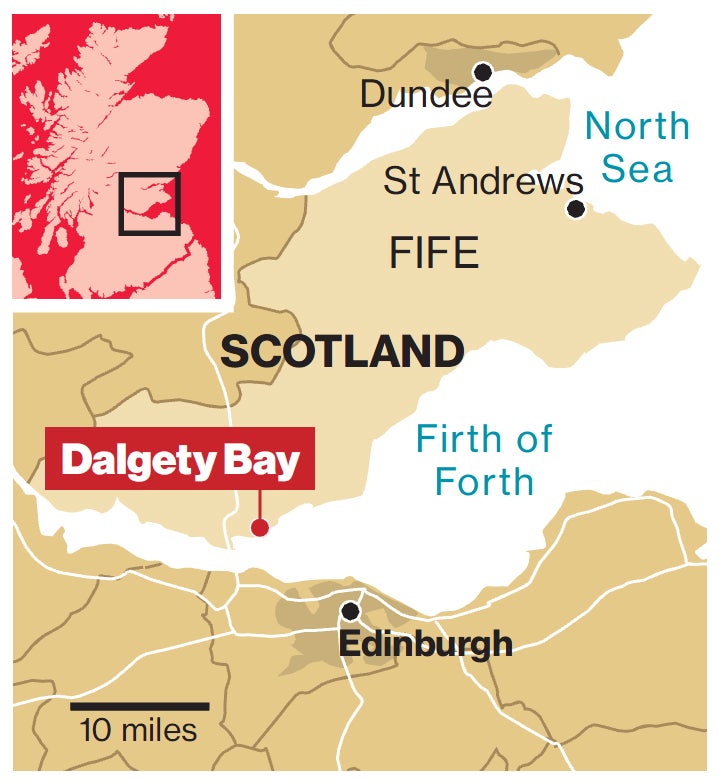Oh I do like to be beside the (radioactive) seaside...
To the fury of locals, a buried cache of radioactive WWII munitions could see Dalgety Bay in Fife become Britain's first nuclear no-go zone. Jonathan Brown visits the scene of an explosive row

Your support helps us to tell the story
From reproductive rights to climate change to Big Tech, The Independent is on the ground when the story is developing. Whether it's investigating the financials of Elon Musk's pro-Trump PAC or producing our latest documentary, 'The A Word', which shines a light on the American women fighting for reproductive rights, we know how important it is to parse out the facts from the messaging.
At such a critical moment in US history, we need reporters on the ground. Your donation allows us to keep sending journalists to speak to both sides of the story.
The Independent is trusted by Americans across the entire political spectrum. And unlike many other quality news outlets, we choose not to lock Americans out of our reporting and analysis with paywalls. We believe quality journalism should be available to everyone, paid for by those who can afford it.
Your support makes all the difference.When Winston Churchill visited Dalgety Bay in October 1940 he paid tribute to the hard work and sacrifice of the men and women engaged in the war effort there.
Over the next five years 40 squadrons were trained or re-equipped at the Royal Naval air base in Fife while 7,000 aircraft were refuelled and repaired.
Until last month that wartime record had been a matter of quiet pride to the suburban community that has sprung up in the peacetime decades on the Firth of Forth.
But two significant finds of radium-226 – left behind by the hasty disposal of aircraft parts on the foreshore following the decommissioning of the base in 1959 – has pitched local people into an increasingly acrimonious battle with the Ministry of Defence.
Now the affluent Edinburgh commuter town which boasts Gordon Brown, the former Prime Minister, as its MP, is facing up to the fact it could become the first place in the United Kingdom to be designated radioactive contaminated land.
Strolling along a small patch of beach closed off to the public because of the potential health risk, Colin McPhail, a retired civil engineer, points out areas of ash uncovered by a storm last winter.
"Over the years since it was discovered there has been concern but everyone has lived with it. But we have to sort this out now. We don't want this to be a legacy for the next generation to deal with," he says.
The first radium particles were found in 1990 by scientists monitoring the nearby nuclear submarine base at Rosyth. No link was established with the base, but instead with the off-shore dumping ground where the incinerated remnants of up to 166 aircraft including American Wildcat fighters and the legendary Seafires were interred.
Paint that was used to make the planes' instruments glow in the dark was immediately suspected and for the past 21 years the situation has been monitored, with an average of 100 tiny particles a year being discovered on the beach at the end of Mr McPhail's road.
But this week the Scottish Environmental Protection Agency (Sepa) said that 468 particles had been discovered since September.
Two of the discoveries – including a large lump of metal – were 10 times more radioactive than anything previously found.
One has been removed while another remains in place on the beach – an area which is home to an internationally successful sailing school and popular with hikers completing the Fife coastal path.
Now local people are starting to worry about what exactly the effects of radium-226, which has a half life of 1,600 years, might be.
Mr McPhail, who is leading negotiations with the MoD on behalf of the community, produced an email from a local woman who said she had lived in Dalgety Bay since childhood, played on the beach, and until recently walked her dog there.
She said: "This year I was treated for breast cancer, and two other mothers from my son's primary class are now being treated for breast cancer too. Also I'm aware of six other people having cancer and they all walked along the beach with their dogs. I have concerns in respect for my children and others if this radiation is causing it."
According to the Health Protection Agency the particles have not led to an increase in detectible background radiation. A study covering the period 1975-2002 showed cancer rates among the local population were normal, although NHS Fife is seeking to update the study.
Until now those using the beach had been advised to wash their hands after going there.
Mr McPhail believes the cost of the clear-up could be £2m.
Helen Eadie, the local MSP and resident of Dalgety Bay, said there had been a change in the Ministry of Defence's attitude since the budget cuts. "Understandably the community is anxious. There is a real sense of anger that the Ministry of Defence is the partner here that is doing the least to address the concerns of the community," she said.
"If it is designated it will be the only land in the UK with that designation, and once that decision has been made there is no stepping back no matter how much remediation is done," she said. Ms Eadie now wants testing of local homes which had previously been given the all clear.
An MoD spokesman said: "The MoD is considering how best to assist Sepa with the recovery and removal of the source of significant radioactivity and is awaiting further information from Sepa."
Join our commenting forum
Join thought-provoking conversations, follow other Independent readers and see their replies
Comments